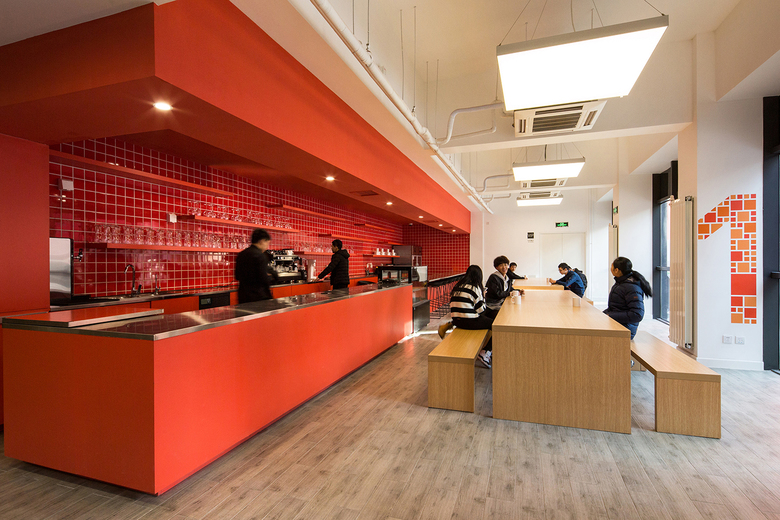6. fevereiro 2019
Photo © YANG Chao Ying
The architects at Crossboundaries in Beijing designed the Chaoyang Future School for Peking University, with the brief to create a new spatial environment for pupils that conveys the new pedagogical content of the classroom.
Client: Affiliated High School of Peking University
Size: 25,916 square metres
Design period (including feasibility study): June 2015–July 2016
Construction period: January–December 2017
Partners in charge: Binke Lenhardt, DONG Hao
Design Team: GAO Yang, Alan Chou, Natalie Bennett, Andra Ciocoiu, Irene Solà, HAO Hong Yi, Cynthia Cui, Tracey Loontjens, Aniruddha Mukherjee, Libny Pacheco, Sidonie Kade, TAN Kebin, FANG Ruo, Chloris Yu, Silvia Campi, WANG Xudong.
Co-operators: BIAD International Studio, BIAD Architectural Design Institute No. 5, BIAD Yuan Jing Landscape Architecture Planning & Design Studio, BIAD Decoration Engineering Design Co., Ltd, Beijing Tian Yi Tong Chuang Culture Development Co., Ltd
Contractor: China Building Technique Group Co., Ltd.
Photographers: WANG Ziling, YANG Chao Ying, DONG Hao
Program:
- Learning Centre: 13,842 square metres
- Art Centre: 2,243 square metres
- Canteen & Misc. Functions: 1,578 square metres
- Apartments: 8,959 square metres
Photo © YANG Chao Ying
The educational system in the People’s Republic of China is facing some fundamental challenges. To date, teaching in schools has been based on passing standardised tests that determine access to colleges and universities. This knowledge has often had little to do with the problems of the real world: understanding how to solve problems requires critical thinking and a questioning of standard answers. New pedagogical approaches are necessary to prepare pupils to develop such an attitude, which in turn require a different spatial setting in the school.
Photo © WANG Ziling
With their renovation of the approx. 26,000 square metres education campus from the 1980s, the Beijing-based architecture practice Crossboundaries shed a completely new light on educational spaces. The experimental programme of the Chaoyang Future School required untypical spaces in which students could learn in self-organised groups and which could accommodate a broad range of learning modules that deviate from traditional standards. Thus, close cooperation between the architects and the school management was indispensable in the design of the rooms and their very diverse spatial qualities.
@ YANG Chao Ying
The architects focused primarily on two aspects; the conventional – the general upgrading of out-dated facilities to the standards of a modern campus, and the unconventional – interventions that lead to multifunctional solutions. Their aim was to achieve a high degree of flexibility, exchange and the reinforcement of an identity that would also be reflected in the attitudes of teachers and pupils.
Photo © YANG Chao Ying
The six existing buildings on the campus sit close together within a very cramped neighbourhood. These buildings were originally planned with identical classrooms arranged side-by-side along faceless corridors. The renovation required the adaptation of this spatial programme in such a way that places for multifunctional use and unconventional learning methods could be created. Interventions were made that altered the spatial boundaries of the rigid existing structure by extending the space of the classrooms in three dimensions, and thereby creating collaborative learning spaces complemented by user-defined furniture that stimulate the new possibilities for creativity and inspiration.
Photo © DONG Hao
Colours also become an important element, in combination with ornamentation, to enable orientation and identity. The green window frame in the entrance area determines the public appearance of the school. Along the facade, the colour scale changes from green to yellow to red for the Art Centre at the heart of the campus. The running track that winds its way organically between the tightly spaced buildings is bright yellow. Based on the window pattern, new square-shaped windows – with their sizes corresponding to the use behind them – were designed to enliven the volumes specified by the existing buildings.
@ YANG Chao Ying
Photo © YANG Chao Ying
The renovation thoroughly transforms the traditional school into an identifiable place; from its landscape, through its administration to its apartments and canteen. The building ensemble gives the school management and the teachers the opportunity to inspire a youth with new methods that establish innovation as the core of learning. At the same time, the way in which the existing building stock is treated makes it clear that the responsibility of architects and society today is to accept existing values and adapt them to the social, economic and ecological needs of the time.
Photo © WANG Ziling
Photo © WANG Ziling
Artigos relacionados
-
Spotlight on Italy
on 16/05/2018
-
Bologna Shoah Memorial
on 20/07/2015
















